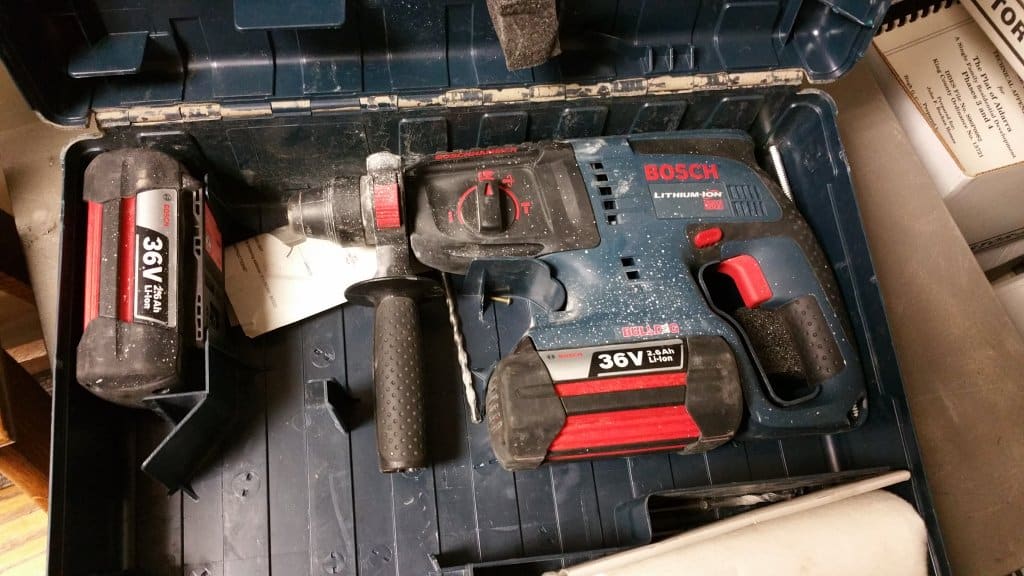I am curious on your opinions on how to tackle corners that fall right on a the face of walk, or other similar situations: on the side of a battered wall, etc...
On many of the corners I set this week there was so much 'under pour' of concrete coming from the bottom the forms that it was hard to get a rebar right next to the face of walk. In some cases I made sure the rebar was at least on line but in 0.10' (or so), and other cases and drilled a tack and washer on the sidewalk. In this case it would still be on line but out about 0.10' (or so).
Well, first you get your 16 pound sledge................then you proceed to knock off any encroaching sidewalk material.........................then you set your marker right where it needs to go. Please note. Avoid doing this if you will need to return to the site any time sooner than two years.
Edit: Keep forgetting to use the sarcasm font and not nearly enuff emoticonceptions.
We drill and place copper caps with magnets under. As a last resort we set reference mons and show the tie on the plat. We make sure to place them where a layperson will still build his fence correctly if he doesn't understand. ..
I would set an offset in the sidewalk, and show such on my survey.
The only place that becomes difficult is when the inspector on a plat insists on having a corner and every single line intersection, with no offsets. Then the sledgehammer must come out.
thebionicman, post: 323394, member: 8136 wrote: We drill and place copper caps with magnets under. As a last resort we set reference mons and show the tie on the plat. We make sure to place them where a layperson will still build his fence correctly if he doesn't understand. ..
We set "online" witness corners on the side lot lines, generally 1' from the property corner, and show them as such on the Plat.
Hilti Drill with a 12" carbide 5/8" bit and generator:whistle:
I agree with the offset method. If the sidewalk is wide enough set them exactly 5' off the corner. In NJ offset markers must be permanently marked as such. If you were to do this, you'd have to drill a hole, set a mag nail and washer with your name/license number and enough room to stamp the word "Offset" or "5' off" or something like that.
I suppose you could just set cross cuts in the sidewalk and maybe do an extra one or two in either direction at the projected property lines of the adjoineers. I think most decent surveyors that came out after you would be able to figure out what was going on.
I would set an even foot offset,star drill concrete,set lead with tack.
To my way of thinking there is really no excuse for not having a cordless rotohammer with a 5/8", 1/2", 1/4" & 7/32" bit along with assorted corded lead, anchors, nails etc. in every survey truck. It's not like the old days when you needed a generator or a thousand dollar tool.
Star drilling a Tk/LD would be a nice trip down memory lane, nothing quite like finding you busted the calc. and need to re-drill with a star drill at the end of a day. 🙂
Since you are from the area, in Seattle it is typical to set the point in the walk on PL extended at an even foot offset, out of the city a bit and it becomes typical to set PL extended to top center curb at no specific offset, a tendency that follows platting sop.
Occasionally I like to go so far as to throw another liner at the intx w/ CL another an older practice from setting out directly on line and cranking direct AZ, I do it if I think the CL will outlast the lot and walk, or to just back up control a bit.
party chef, post: 324212, member: 98 wrote:
Star drilling a Tk/LD would be a nice trip down memory lane, nothing quite like finding you busted the calc. and need to re-drill with a star drill at the end of a day. 🙂
You and I have different ideas of what a "nice trip down memory lane" means. I am not a big fan of a star drill.
I am a BIG fan of this:
Yea, those are good tools, DeWalt makes a nice one also that is lighter weight for if you do lots of walking.
Even if they don't fall in the sidewalk or curb, you should set permanent reference points in the sidewalk or curb on even foot distances from the corner. If you are staking a row of corners, try to use the same distances.
I do not suggest setting anything less than one foot from the corner. That can lead to real confusion, particularly in my world with no recording requirements or realistic possibilities of recording surveys, except for subdivision plats.
I meant to add that you should ask the PLS who is certifying the survey how they want them set.
X-mark or crow's foot scribed in the concrete at the correct location, and a reference rebar with appropriate cap set 1' interior to the lot for most subdivisions. In urban settings, where you know everything is going to be either paved or concrete, a drilled hole with a nail and flasher.




